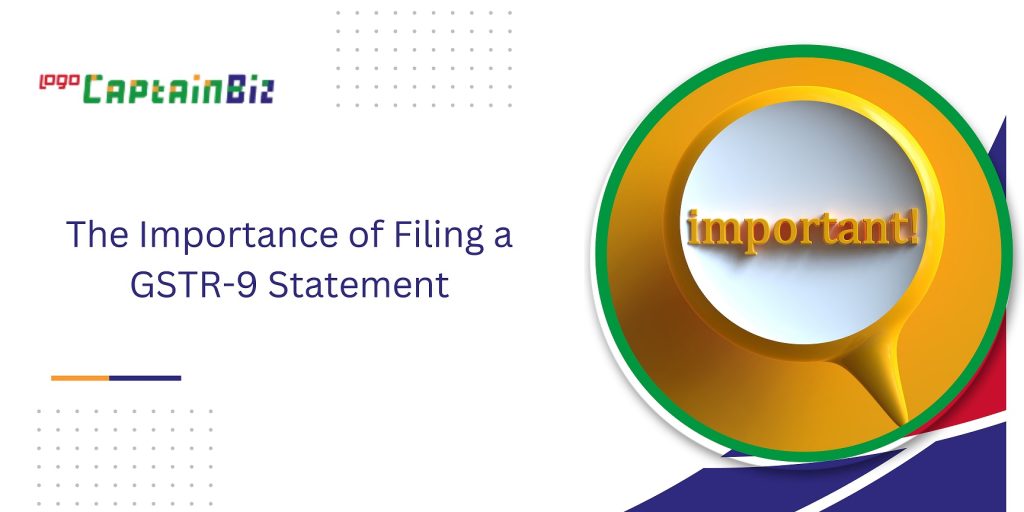GTSR-9’s reconciliation of turnover and tax liability is important because it helps make sure all the reported data is consistent and accurate. It’s a critical step in the whole process because it’s mostly about accuracy and compliance. In other words, accurate reporting of tax liability and turnover is needed for valid GST compliance.
What is GSTR-9?
The GSTR-9 return is a statement or document that a taxpayer must file once annually. This document contains the finite details of supplies received and made under the numerous tax heads, for instance, IGST, SGST, and CGST, during the whole year, as well as audit and turnover data for the same.
The government now provides the GSTR-9C audit form, which taxpayers who’ve got a turnover of over Rs. 2 crore need to file every year. It’s basically a reconciliation document between the taxpayer’s audited annual financial statements and the annual returns according to the GTSR-9 form.
What’s the Filing Due Date?
There’s been an extension of the GSTR-9 filing due date for the 2022-2023 financial year for more than Rs. 2 crore. The last date of filing has been moved to 31st December from 31st September. For example, if you’re filing for 2022, that’s last year, then you’ll now need to file it before 31st December 2023 instead of 31st September 2023.
The Reconciliation Process
When it comes to the reconciliation part, it helps identify mismatches or discrepancies between the data recorded in GSTR-3B, GSTR-1, and the last GSTR-9 return. Discrepancies and mismatches can arise because of many different reasons, for example, missed filings, data entry errors, or when certain transactions have been treated differently. The reconciliation process allows the taxpayer to identify these mismatches and discrepancies.
Taxpayers who miss filing their GSTR-9 statement can file a pending GSTR-9 between 1st April 2023 – 30th June 2023. However, they may still have to pay a reduced late fee of as much as INR 20,000.
Steps for Reconciliation
Here are some steps to help ensure your tax liability and turnover data align accurately.
- Collect Data: Gather any relevant information, including tax payment documents, purchase records, and sales invoices, for the financial year being considered.
- Review GSTR–3B and GSTR-1: Compare the information recorded in your quarterly or monthly GSTR-3B and GSTR-1 return forms with your annual financial records. Make sure that all the figures match.
- Identify Discrepancies: If you find any mismatches or discrepancies between the information recorded in your annual financial records and tax returns, try to find out why and the reasons behind them. Common discrepancies or mismatches typically include omissions in returns, incorrect tax calculations, and missing invoices.
The Importance of Filing a GSTR-9 Statement

- Most financial and bank institutions require borrowers to submit their annual financial reports and the statutory balance sheet along with their GST annual statements. A borrower typically has to give the lending bank their compliance status declaration for the annual renewal of credit facilities.
- Just like the income tax return submission, GSTR-9C and GSTR-9’s GST annual returns are important documents because they not only help prove compliance status but the health of the business too. This annual financial statement provides a way to look at yearly data regarding sales as well as the ITC the business has access to.
- Furthermore, filing this statement can also help boost your compliance score. On-time filing of these returns is one of the main things that can help you improve your compliance rating, which is a crucial factor as far as vendor shortlisting is concerned.
- Large corporations select vendors objectively and often prefer those that have high compliance ratings. It helps them make sure their suppliers report purchases and allows them to easily provide input tax credit facilities without involving a lot of follow-up.
- Lastly, a taxpayer can use the GSTR-9 statement as documentary evidence in any future court proceedings that may arise. The GSTR-9 statement compiles yearly information on GST liability, turnover made after analyzing the different return files, ITC claimed, etc. Unfortunately, with that said, some taxpayers might be tempted to find various ways to manipulate data, especially when it comes to sales and turnover, so that they ensure they stay within the Rs 2 crore scope for claiming the filing tax returns exemption.
How to file GSTR 9C Offline utility – General issues faced and how to solve them
Conclusion
The reconciliation and tax liability in GSTR-9 are an incredibly important part of the whole filing process. As highlighted above, it helps ensure the data a taxpayer reports to the authorities at GST is consistent and accurate and complies with all the GST regulations.
By conducting thorough reconciliation and following some of the steps mentioned in this article, a taxpayer can decrease the risk of audits, avoid penalties, and maintain a good reputation and relationship with the tax officials. In addition, using GST reconciliation software or seeking professional assistance can help improve accuracy and streamline processes, making it a great asset for companies of any size.